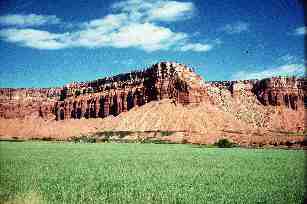|
Weathering, Erosion, and Mass Movement SlopesA slope is an inclined ground surface. Most slopes are mantled
with unconsolidated regolith, the product of weathering. Regolith serves as parent material for soil
above and grades downward into
unaltered bedrock below. Loose regolith serves as a source of colluvium,
sediment that has been eroded, transported and deposited down slope. In order to do so, the erosional forces must overcome
the forces of resistance: friction, inertia (the resistance to movement), and
particle cohesion. WeatheringWeathering is the breakdown and decomposition of earth material, namely rocks. Weathering is an important mechanism to destabilize surface materials for their eventual removal by erosive processes. Weathering of rock-forming minerals can create new products from pre-existing rocks. The physical disintegration of rocks affects soil development and texture. Weathering releases chemical compounds that become available for biological processes. The weathering of carbonate minerals releases carbon to the atmosphere which impacts atmospheric chemistry and temperature. And the list goes on. Weathering, needless to say, is an important environmental process that bridges all elements of our physical environment and sustains the notion of a changing Earth.
Weathering occurs in two ways. Physical weathering, also called mechanical weathering, involves the disintegration of rock materials. Physical weathering incurs no change in the chemistry of the material being altered. Instead, it simply breaks large pieces into smaller ones. Chemical weathering involves the decomposition of rocks and sediment. In this case, a chemical change occurs and a new product is created from the material that has undergone weathering. Weathering processes are determined by the climate and vegetation of a place. Dry locations tend to be dominated by physical weathering and moist places by chemical weathering. |

